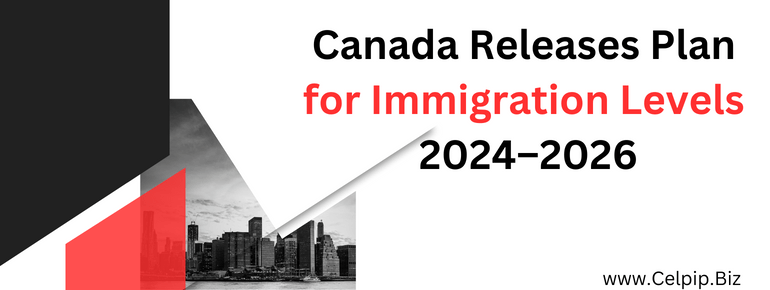

Canada Releases Plan for Immigration Levels 2024–2026
Canada Releases Plan for Immigration Levels 2024–2026: The Immigration Levels Plan for Canada for 2024–2026 has just been released. Canada will keep its current immigrant goals in place for the time being.
The country plans to admit 485,000 more immigrants by 2024. In the years 2025 and 2026, Canada intends to open its doors to a total of 500,000 new immigrants annually.
The goals are the same as those set out in the Immigration Levels Plan 2023–2025. Today, new information was released about the goal for 2026 and changes to the number of immigrants that will be allowed into each class and program from 2024 to 2026.
Class-based breakdown of immigration targets
For the year 2024, Canada wants to bring in about 281,135 immigrants from the economic class, which is 58% of the yearly goal. This number will go up to 301,250 immigrants by 2026, which is 60% of the yearly goal.
In 2024, the goal for the family class will be 114,000 immigrants, or 24% of all entries. This number will go up to 118,000 immigrants by 2026, which is 24% of all who arrive in.
In 2024, the goal for humanitarian admissions is 89,865 immigrants, which is about 19% of all admits. These numbers include refugees, people who need to be protected, and people who are allowed to come in for caring, humanitarian, or other reasons. The goal is to have 80,832 immigrants, or 16% of all entries, by 2026.
Keep in mind that rounding means that numbers may not add up to 100%.
Increased targets for Express Entry and the PNP
The goal for Express Entry will be to let 110,700 people become permanent residents in 2024. In 2025 and 2026, this number will rise to 117,500 foreigners.
The Provincial Nominee Program (PNP) wants to bring in 110,000 newcomers in 2024. That number will go up to 120,000 in 2025, and then again to 120,000 in 2026.
The goal for spouse, partner, and child support is to let 82,000 people in in 2024. This number will go up to 84,000 in 2025 and 2026. The Parents and Grandparents Program (PGP) wants to bring in 32,000 foreigners in 2024, and then another 34,000 in each of 2025 and 2026.
Canadian officials want to keep immigration numbers stable.
Concerning the reason for not changing its goals, the Canadian government says, “This plan is designed to support economic growth while balancing the pressures in areas like housing, healthcare, and infrastructure.”
It sets a reasonable course for population growth that will last and stay stable…Starting in 2026, the government will keep the number of permanent residents at 500,000. This will give people time to get used to living in Canada while also continuing to add to the job market.
Over the next year, the government also plans to change the number of temporary resident entries to make sure that this part of our immigration system can continue to work.
The Immigration and Refugees Protection Act (IRPA) is Canada’s main immigration law. In years when there are no elections, the federal government has to release its yearly immigration plan by November 1.
There are three types of immigration to Canada: economic, family, and social. The Immigration Levels Plan tells us how many new permanent residents will be allowed to come in each year for the next three years.
Immigration, Refugees, and Citizenship Canada (IRCC) wants to improve Canada’s economy, bring families back together, and make the country a safe place for people fleeing violence or other humanitarian crises. This plan helps them reach their goals.
With 437,000 newcomers, Canada broke the record for most people coming to live there in 2022. The goal for people who become regular residents in 2023 is 465,000.
Canada is working on a new plan to make the visa system better.
The Immigration Levels Plan 2024–2026 comes just one day after Canada announced a new plan to make its immigration system better. On October 31, Marc Miller, the country’s immigration minister, said that the system was not perfect and laid out the main ideas for a new way to make it better.
The main goals of the new plan, called An Immigration System for Canada’s Future, are as follows:
It is the goal of IRCC to make the experience of its clients better and easier to use.
IRC also wants to make sure that Canada’s immigration policies are more in line with its skills and labour plan.
Third, IRCC wants all three levels of government in Canada to work together on a plan to make sure the country can provide enough homes, health care, and infrastructure for its growing number of newcomers.
Immigration to Canada commenced to rise in the late 1980s.
In the late 1980s, Canada’s immigration policy started to change into what it is today. Before this, the government didn’t put as much thought into planning for future immigration. Instead, they set immigration goals based on how the economy was doing at the time.
In 1984, Canada took in less than 90,000 newcomers. The federal government, which was run by the Conservative party at the time, knew there would soon be a lack of workers as the 1990s got closer. They set new immigration goals of 250,000 permanent residents over eight years.
Then, in 1993, the Liberal government was elected, and they kept raising immigration goals. It also started to focus more on letting immigrants from the economic class come in and cutting back on the number of people from the family and charity classes coming in to help the economy during slumps.
Up until the current Liberal government was chosen in 2015, about 260,000 immigrants were let in each year. Under the current federal government, which is led by Prime Minister Justin Trudeau, the goals were raised to 300,000 and then to 340,000 just before the COVID-19 pandemic in 2020.
Even though there were limits because of the pandemic, Canada welcomed 405,000 new immigrants in 2021, breaking its previous record for permanent residents.
Several polls show that Canadians are less interested in immigration than they were in the past because of the country’s housing shortage and affordability problem.
However, IRCC is still setting high immigration goals because there is a lack of trained workers due to a low birth rate and the fact that millions of Canadian workers will be retiring when they turn 65. Stats Canada’s most recent estimate of the country’s population shows that 98% of its growth is due to foreigners.
For July 2023, the most recent data on open jobs says that there were 701,300 open jobs in Canada. Even though there are 273,700 fewer open jobs than there were a year ago, this is still a big enough drop for IRCC to make some changes to important immigration programs and processes, like Express Entry.
Earlier this year, IRCC started category-based selection rounds for Express Entry candidates who have work experience in an in-demand sector or the ability to promote the French language outside of Quebec. This was done to better target economic immigrants who can help Canada close the labour force gap.
Quebec’s immigration strategy for 2024-2026.
Today, Quebec also put forward its plan for the number of immigrants in 2024 and 2025. Quebec is the only Canadian province that can set its own yearly goals for permanent resident admissions.
This is because of their unique position in Canada. Quebec can choose how to handle immigration in a way that helps protect its unique francophone identity. The province said today that it wants to bring in 50,000 new immigrants in 2024 and another 50,000 in 2025.
Summary:
1. What are the immigration goals for Canada in 2024–2026?
Canada plans to admit 485,000 more immigrants by 2024. In 2025 and 2026, the goal is to open doors to a total of 500,000 new immigrants annually.
2. How is the immigration breakdown by class in Canada during this period?
In 2024, the economic class aims for 281,135 immigrants (58%), family class targets 114,000 (24%), and humanitarian admissions aim for 89,865 (19%). By 2026, the economic class increases to 301,250 (60%), family class to 118,000 (24%), and humanitarian admissions decrease to 80,832 (16%).
3. What are the increased targets for Express Entry and the Provincial Nominee Program (PNP)?
In 2024, Express Entry aims for 110,700 permanent residents, increasing to 117,500 in 2025 and 2026. The PNP targets 110,000 newcomers in 2024, increasing to 120,000 in 2025 and 2026.
4. Why is Canada keeping its immigration numbers stable?
The Canadian government aims to support economic growth while balancing pressures in areas like housing, healthcare, and infrastructure. The plan provides a stable course for population growth, with the intention to maintain 500,000 permanent residents annually from 2026.
5. What is the main focus of Canada’s new immigration plan, “An Immigration System for Canada’s Future”?
The main goals include creating a more welcoming environment for newcomers, aligning immigration policies with skills and labor needs, and developing a comprehensive plan for growth. It aims to improve the overall experience for clients and ensure collaboration between all levels of government for adequate infrastructure and services.
6. How has Canada’s immigration policy evolved over the years?
In the late 1980s, Canada shifted its immigration policy to address future needs. The focus transitioned to planning for economic immigrants, with increasing goals under Liberal governments. The current government, led by Prime Minister Justin Trudeau, raised goals to 340,000 before the COVID-19 pandemic, and even with pandemic limitations, Canada welcomed 405,000 new immigrants in 2021.
7. Why is Canada maintaining high immigration goals despite some public concerns?
Canada faces a shortage of trained workers due to a low birth rate and an aging workforce. About 98% of the country’s population growth comes from immigrants. The high immigration goals are set to address the labor force gap, especially considering the upcoming retirements of millions of Canadian workers.
8. How is Quebec’s immigration strategy different from the rest of Canada?
Quebec is the only Canadian province with the authority to set its own yearly goals for permanent resident admissions. This autonomy allows Quebec to handle immigration in a way that aligns with its unique francophone identity. Quebec plans to bring in 50,000 new immigrants in 2024 and another 50,000 in 2025.
9. How is Canada addressing changes in the job market and open job positions?
Despite a decrease in open jobs compared to the previous year, Canada had 701,300 open jobs in July 2023. The Immigration, Refugees, and Citizenship Canada (IRCC) is making adjustments to important immigration programs like Express Entry, including category-based selection rounds, to target economic immigrants who can help address the labor force gap.
10. How can individuals stay informed about Canada’s immigration updates?
Individuals can stay informed by regularly checking updates from Immigration, Refugees, and Citizenship Canada (IRCC). The federal government is required to release its yearly immigration plan by November 1 in years without elections, and additional announcements and changes may be communicated through official channels.
Check out our Web Story at Canada Releases Plan for Immigration Levels 2024–2026
In a significant move to address the growing demand for skilled home care professionals, Canada…
In a significant move to address the acute labor shortages in its construction sector, the…
In a move to combat rising inflation and ensure fair compensation for workers, Canada has…
The Canadian government has announced an investment of up to $14.3 million to address the…
The Canadian Express Entry system has undergone significant changes for 2025, focusing on aligning immigration…
New Brunswick has officially opened the intake for two enhanced Provincial Nominee Program (PNP) pathways,…



